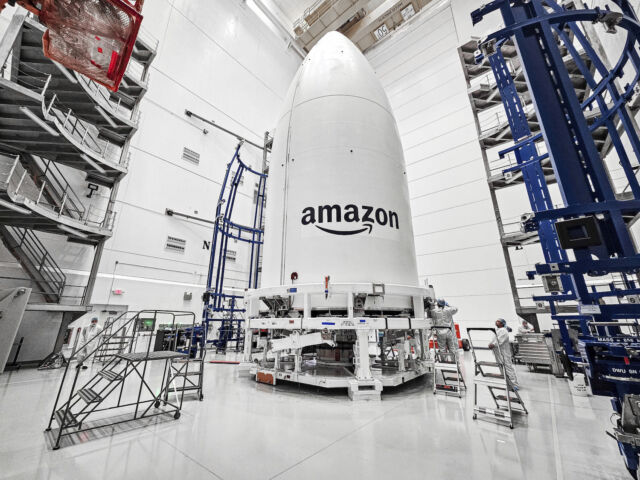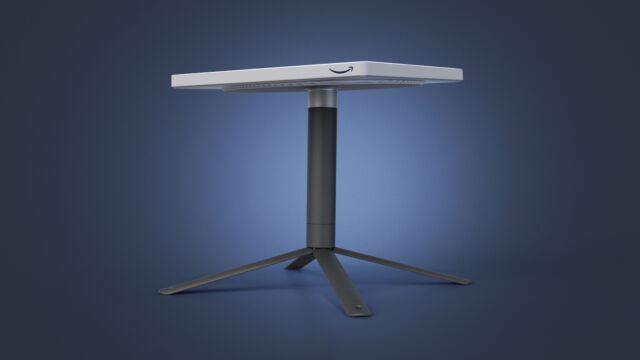Amazon really doesn't want to show anyone what its Internet satellites look like.
The first two prototype satellites for Amazon's broadband network launched Friday from Florida, the first in a series of at least 77 rocket launches the retail giant has booked over the next six years to deploy a fleet of more than 3,200 spacecraft to rival SpaceX's Starlink system.
These first two satellites for Amazon's $10 billion Internet megaconstellation, called Project Kuiper, took off on top of a United Launch Alliance Atlas V rocket from Cape Canaveral Space Force Station in Florida at 2:06 pm EDT (18:06 UTC).
On its 99th flight, ULA's Atlas V rocket fired a Russian-made RD-180 engine and thundered off the launch pad, heading east from the Florida coastline over the Atlantic Ocean. The kerosene-fueled engine—flying without the aid of solid rocket boosters on this flight—fired more than four minutes, then a hydrogen-burning engine on the rocket's Centaur upper stage took over for a 10-minute burn to reach a targeted 311-mile-high (500-kilometer) orbit.
Amazon's two test satellites separated from the rocket about 18 minutes after liftoff. ULA, a 50-50 joint venture between Boeing and Lockheed Martin, confirmed the launch phase of the mission was a success.
“This initial launch is the first step in support of deployment of Amazon’s initiative to provide fast, affordable broadband service to unserved and underserved communities around the world,” said Gary Wentz, ULA's vice president of government and commercial programs, in a press release.
Amazon is aiming to become the third company with a satellite megaconstellation to provide high-speed Internet service from space.
SpaceX said last month its Starlink network, with more than 4,000 operational satellites, has surpassed 2 million active customers and is available on all seven continents. SpaceX continues to launch satellites, sometimes multiple times per week, to add capacity to the Starlink network. OneWeb, which recently merged with the French satellite company Eutelsat, has more than 600 satellites beaming broadband signals from orbit. The slightly higher altitude of OneWeb's satellites means that its network doesn't require as many spacecraft for global coverage.
Amazon's Kuiper constellation will number 3,236 satellites, spread out in 98 orbital planes, or pathways, crisscrossing the planet at an average altitude of about 380 miles (610 kilometers). In its license application with the Federal Communications Commission, Amazon said the Kuiper satellites will fly in mid-inclination orbits, enabling Internet service for customers between 56 degrees north and south latitude.
The two prototype satellites that launched Friday from Cape Canaveral will go through a comprehensive test campaign in orbit. In a press release earlier this week, Amazon wrote that this mission, called the "Protoflight" mission, "will help the Project Kuiper team improve the technology and operations required to deliver fast, affordable broadband from space."

Amazon's first two prototype Internet satellites were buttoned up for launch inside the payload fairing of an Atlas V rocket.
Amazon
"We’ve done extensive testing here in our lab and have a high degree of confidence in our satellite design, but there’s no substitute for on-orbit testing,” said Rajeev Badyal, Project Kuiper’s vice president of technology, in a company statement. “This is Amazon’s first time putting satellites into space, and we’re going to learn an incredible amount regardless of how the mission unfolds.”
These pathfinder spacecraft, called KuiperSat 1 and KuiperSat 2, were built in-house by Amazon at a factory in Redmond, Washington. Their mission is to not only test the performance of Amazon's new satellite design, but also to eventually have Amazon engineers connect the satellites to the Internet using gateway antennas positioned around the world.
"As the mission progresses, we will test the network from end to end, sending data back and forth between the Internet, our ground gateways, the satellites, and our customer terminals," Amazon said.
Finding a ride
KuiperSat 1 and 2 have been ready to fly to space since March, when Amazon shipped the spacecraft from Washington to a satellite processing facility near Cape Canaveral. They were booked to fly on the inaugural test flight of ULA's new Vulcan rocket alongside a commercial lunar lander from Astrobotic. However, that mission was delayed from May until the end of this year, at the earliest, following an accident during testing of the rocket's upper stage.
This prompted Amazon to switch the launch of the prototype satellites from the Vulcan to ULA's legacy rocket, the Atlas V, which the Vulcan will eventually replace. There was an open launch slot available on an Atlas V in the autumn after several other payloads on ULA's launch schedule ran into problems.
Before they were supposed to fly on the Vulcan rocket, the Amazon Kuiper testbeds were contracted to fly on a new rocket from the startup launch company ABL Space Systems. Last year, Amazon moved the satellites off ABL's rocket and onto the first Vulcan launch with ULA.

Amazon hasn't released any pictures or artist's illustrations of its Kuiper satellites, but this picture
of one of the spacecraft's shipping containers provides a sense of the size of each one.
Amazon
Amazon signed the largest commercial launch contract in history, snatching up rides on ULA's new Vulcan rocket, Blue Origin's New Glenn, and Arianespace's Ariane 6 launcher. All told, Amazon has purchased 77 launches: 38 Vulcan launches, plus nine flights on ULA's soon-to-retire Atlas V, 18 Ariane 6 rockets, and 12 New Glenn missions, with a contract option for 15 more. Each rocket will carry several dozen operational Kuiper satellites to space on a single mission.
The strategy for launching Amazon's Project Kuiper satellites has seemed to be to use every available Western medium- or heavy-lift rocket except SpaceX's Falcon 9. In August, shareholders of a pension fund that includes Amazon stock sued the company and its founder, Jeff Bezos, for "breaching their fiduciary duty" by passing over SpaceX's launch services in their multibillion-dollar rocket procurement for Project Kuiper.
The lawsuit alleges SpaceX, despite offering lower prices and better launch availability, was never considered due to an intense and personal rivalry between that launch company's founder, Elon Musk, and Bezos, who has a competing rocket company in Blue Origin.
The FCC's license for Project Kuiper requires Amazon to deploy half of the constellation by July 2026. That would require at least two launches per month, and perhaps more, from Amazon's stable of launch service providers. In July, Amazon unveiled a dedicated satellite processing facility at NASA's Kennedy Space Center in Florida to prepare Kuiper spacecraft for their launches.
Amazon said it is beginning production of operational Kuiper satellites in parallel with testing of the prototype satellites in orbit. In July, Amazon said its Kuiper factory should be ready to start churning out production satellites by the end of this year. The first batch of production satellites is on track for launch in the first half of 2024, presumably on an Atlas V rocket, with beta testing commencing by the end of 2024.
Silent treatment
Amazon is keeping quiet about the details of the Kuiper satellites. The company did not release any photos of the spacecraft, or even any artist's illustrations, before the Protoflight launch Friday. SpaceX and OneWeb published imagery of their broadband satellites before they launched into space.
Amazon has not revealed much about the design of its Kuiper satellites other than that they are three-dimensional in shape, not flat-packed for launch like SpaceX's Starlink broadband satellites. Each Kuiper spacecraft likely weighs a few hundred kilograms at launch, so a dedicated Atlas V launch into low-Earth orbit for just two of Amazon's satellites is a bit of overkill.
But it's clear Amazon saw the benefit in getting KuiperSat 1 and 2 into orbit a few months sooner than would have been possible if the company waited for Vulcan. This launch used up one of the nine Atlas Vs that Amazon has reserved for Kuiper missions. These nine Atlas Vs for the Kuiper program equal half of the total number of Atlas V rockets—18—left in ULA's inventory going into Friday's launch.

Amazon has released this image of a customer terminal for the Project Kuiper network. The
phased-array antenna is similar in appearance to a SpaceX Starlink user terminal.
Amazon
To add another layer of secrecy to this launch, ULA's live broadcast Friday ended after separation of the Atlas V's first stage from the Centaur upper stage about five minutes after liftoff. This was at the request of Amazon, the ULA spokesperson said.
This policy of cutting off live coverage before the rocket reaches orbit is similar to what ULA does during launches of US government spy satellites. In those cases, the government's spy satellite agency requests the launch provider to end the public webcast shortly after liftoff, similar to what Amazon has asked for Friday's launch.
An Amazon spokesperson did not respond to questions from Ars about why the company is not releasing imagery of its Kuiper satellites, or why it asked ULA to end launch coverage so soon after liftoff.
What we do know is the rocket targeted an orbit about 311 miles above Earth, with an inclination of 30 degrees to the equator. After deployment from the launcher, the satellites were expected to contact Amazon's ground stations and extend solar panels to generate power. KuiperSat 1 and 2 could also test hall-effect thrusters, or ion engines, that will be used to maneuver future Kuiper satellites in orbit.
At the end of the test mission, Amazon says it plans to "actively deorbit" both prototype satellites to allow them to ultimately burn up in Earth's atmosphere.
Oct. 6, 2023: This story was updated after the successful launch of the Kuiper satellites.
Source




3175x175(CURRENT).thumb.jpg.b05acc060982b36f5891ba728e6d953c.jpg)



Recommended Comments
There are no comments to display.
Join the conversation
You can post now and register later. If you have an account, sign in now to post with your account.
Note: Your post will require moderator approval before it will be visible.